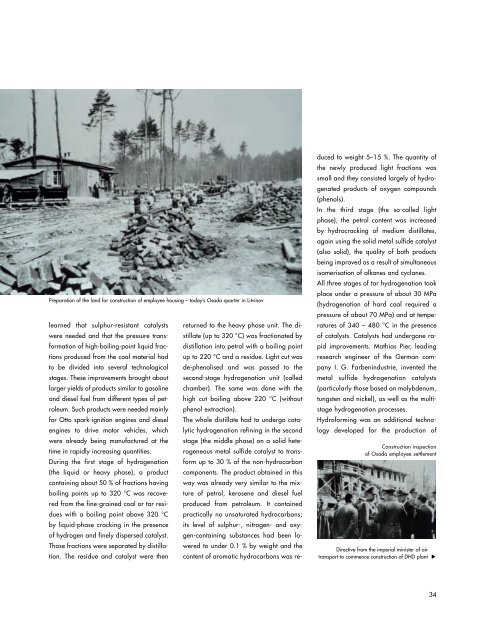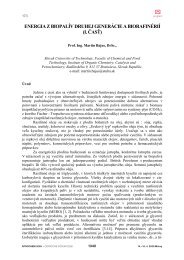THE CENTURY OF PETROL - Petroleum.cz
THE CENTURY OF PETROL - Petroleum.cz
THE CENTURY OF PETROL - Petroleum.cz
You also want an ePaper? Increase the reach of your titles
YUMPU automatically turns print PDFs into web optimized ePapers that Google loves.
Preparation of the land for construction of employee housing – today’s Osada quarter in Litvínov<br />
learned that sulphur-resistant catalysts<br />
were needed and that the pressure transformation<br />
of high-boiling-point liquid fractions<br />
produced from the coal material had<br />
to be divided into several technological<br />
stages. These improvements brought about<br />
larger yields of products similar to gasoline<br />
and diesel fuel from different types of petroleum.<br />
Such products were needed mainly<br />
for Otto spark-ignition engines and diesel<br />
engines to drive motor vehicles, which<br />
were already being manufactured at the<br />
time in rapidly increasing quantities.<br />
During the first stage of hydrogenation<br />
(the liquid or heavy phase), a product<br />
containing about 50 % of fractions having<br />
boiling points up to 320 °C was recovered<br />
from the fine-grained coal or tar residues<br />
with a boiling point above 320 °C<br />
by liquid-phase cracking in the presence<br />
of hydrogen and finely dispersed catalyst.<br />
Those fractions were separated by distillation.<br />
The residue and catalyst were then<br />
returned to the heavy phase unit. The distillate<br />
(up to 320 °C) was fractionated by<br />
distillation into petrol with a boiling point<br />
up to 220 °C and a residue. Light cut was<br />
de-phenolised and was passed to the<br />
second-stage hydrogenation unit (called<br />
chamber). The same was done with the<br />
high cut boiling above 220 °C (without<br />
phenol extraction).<br />
The whole distillate had to undergo catalytic<br />
hydrogenation refining in the second<br />
stage (the middle phase) on a solid heterogeneous<br />
metal sulfide catalyst to transform<br />
up to 30 % of the non-hydrocarbon<br />
components. The product obtained in this<br />
way was already very similar to the mixture<br />
of petrol, kerosene and diesel fuel<br />
produced from petroleum. It contained<br />
practically no unsaturated hydrocarbons;<br />
its level of sulphur-, nitrogen- and oxygen-containing<br />
substances had been lowered<br />
to under 0.1 % by weight and the<br />
content of aromatic hydrocarbons was re-<br />
duced to weight 5–15 %. The quantity of<br />
the newly produced light fractions was<br />
small and they consisted largely of hydrogenated<br />
products of oxygen compounds<br />
(phenols).<br />
In the third stage (the so-called light<br />
phase), the petrol content was increased<br />
by hydrocracking of medium distillates,<br />
again using the solid metal sulfide catalyst<br />
(also solid), the quality of both products<br />
being improved as a result of simultaneous<br />
isomerisation of alkanes and cyclanes.<br />
All three stages of tar hydrogenation took<br />
place under a pressure of about 30 MPa<br />
(hydrogenation of hard coal required a<br />
pressure of about 70 MPa) and at temperatures<br />
of 340 – 480 °C in the presence<br />
of catalysts. Catalysts had undergone rapid<br />
improvements. Mathias Pier, leading<br />
research engineer of the German company<br />
I. G. Farbenindustrie, invented the<br />
metal sulfide hydrogenation catalysts<br />
(particularly those based on molybdenum,<br />
tungsten and nickel), as well as the multistage<br />
hydrogenation processes.<br />
Hydroforming was an additional technology<br />
developed for the production of<br />
Construction inspection<br />
of Osada employee settlement<br />
Directive from the imperial minister of air<br />
transport to commence construction of DHD plant<br />
▲<br />
34



